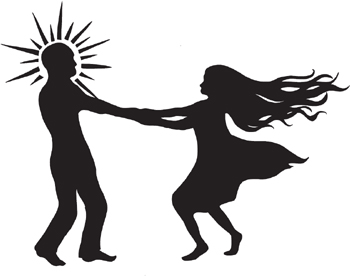
Once there were two suns in the sky. Two hot flaming suns, both of them heating and parching the earth. They didn’t shine at the same time. They took turns dancing round the earth, so that it was always bright burning day, never cool dark night.
It was so hot that plants were dying, rivers were drying, and people were desperate for relief from the heat of the two suns.
So a young girl called Kopecho said that they should get rid of one of the suns. “One sun is enough,” she whispered, so the suns up high wouldn’t hear her. “Let’s get rid of the other one.”
“How would we do that?” the rest of the Yupa tribe whispered back.
“We could drop one sun down a hole deep enough to put out his light for ever.”
“But who would do that? Who would risk the anger of the suns to trick and attack them?”
Kopecho looked round, hoping someone else would volunteer. But no-one did. It was her plan, and they were all staring at her.
She knew that whoever attacked the suns risked death, but also that everyone in her tribe would soon die in this endless burning daylight.
So Kopecho tied her hair back and prepared a feast.
She lit a fire to bake flat bread and to grill the largest fish she could catch in the shallow river, then she picked the juiciest fruit she could find in the shrinking forest.
She dug a pit, so deep and dark that even the suns up high couldn’t see its bottom, if they bothered to look. But Kopecho had asked everyone in her tribe to dig that day, and hundreds of people were digging ditches, toilets, graves and foundations for huts, so that if the suns looked down they wouldn’t notice one young girl digging a deep pit.
When she had dug as far down as she could, when her tools struck stone rather than earth, she climbed out of the pit, and covered it with thin sticks and broad leaves. Then she let her hair out and called the suns down to a feast.
“Look what I have cooked for you, suns. I admire your heat and light, and your dance in the sky, so I have made you a feast.”
The suns came down to earth, to join her in the feast.
She fed them. She sang to them. She flattered them.
Then she said, shyly, hiding her mouth behind her long black hair, “I love to watch you both dance in the sky. Would you please dance with me?”
She stood up and whirled round, her long black hair spreading out like sun’s rays. She turned and twirled, she jumped and spun.
The suns laughed and they both got up to dance with her.
The suns liked to dance in curves and circles because they were used to dancing across the sky, but now the girl danced in a straight line, backing towards the pit, leading the suns along with her.
Kopecho realised that she couldn’t let both the suns fall in the pit, because no day would be as bad as no night. So she grasped the hand of one sun and though his heat burnt her fingers, she smiled as she spun him away from the pit. Then she grasped the hand of the other sun, and she laughed as she spun him towards the pit.
She leapt backwards, right over the pit, pulling the sun with her, and he landed heavily on the leaves and sticks.
The sticks broke, the leaves fluttered down.
And the sun dropped into the pit.
The sun screamed as he fell.
The other sun stopped dancing. The girl stood on the edge of the pit. They watched the sun’s light flicker as he fell down the deep dark hole.
Then the sun hit the hard stone at the bottom and his light faded.
But his light didn’t go out completely.
The fall didn’t kill the sun, it just injured him. The fall didn’t put out his heat and his light, it just cooled the heat and dimmed the light.
So he hauled himself out of the pit, crawled back into the sky, and tried to shine again. But he didn’t shine as bright, he shined colder and bluer and less often.
He became the moon.
He still danced with his brother, sun and moon circling in the sky.
And the people were happy. They had a sun in daytime and a moon at night, and just enough light and heat, balanced by enough dark and cold, to live and grow and thrive.
But the moon and his brother the sun were furious with Kopecho, who had tricked them with food and dance, and had broken their power.
So one early morning when the sun was rising and the moon was still visible, they linked their rays, they picked Kopecho up, and they threw her into the river to drown.
But as she tumbled through the air, Kopecho turned into a frog, and was able to live healthy and happy in the river.
Then, over the years, because of her wisdom, her courage and her knowledge of the depths from digging down so deep, Kopecho became the Yupa goddess of the underworld, safe and hidden forever from both the sun and the moon.